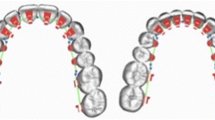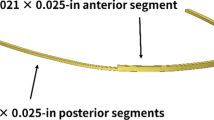Abstract
Transpalatal arches are used in passive mode to improve anchorage and in activated mode to achieve single tooth movement or movement of segments of teeth in first-, second- and third-order. Clinically it seems that the commonly used palatal arches of the Goshgarian type (here in the MIA system) as well as the precision TMA lingual arches of the Burstone system are not equally suitable for all kinds of activation.
Using the Orthodontic Measurement and Simulation System (OMSS) the force systems and the efficacy of activated arches of both systmes were examined in an experimental study with respect to different malposistions. The following first-, second- and third-order activations wer chosen: symmetrical expansion and compression up to 4 mm, symmetrical distal rotation up to 15°, unilateral distal tipping of 15° and symmetrical buccal root torque up to 10°. Attachments of the MIA system (MIA Rotation Lingual Sheaths, 0.072”× 0.036”) and of the Burstone system (precision lingual hinge cap, 0.032”× 0.032” unused and a pair after a 4-week intraoral application period) were measured. Lingual arches made of 0.036” round stainless steel wire (MIA) and 0.032”× 0.032” TMA (Burstone system) were prepared with a height of 18 mm and a width of 30 mm.
First-order activation bends (expansion and compression) of the MIA palatal arches caused forces up to 4.4 N compared to 1.8 N of the TMA arches, due to the lower load/deflection rate of the latter. The malpositions were corrected effectively both systems. Due to the higher stiffness the moments delivered by the MIA palatal arches (39 Nmm) were higher in distal rotation compared to those of the TMA arches (14 Nmm) and the correction was more effective. In second-order activations (tipping) the MIA system delivered no or only small moments because of the curved shape of the attachments. A correction of only 30% was achieved compared to 80% with the Burstone system. In third-order activations, in contrast, the Burstone attachments caused considerable loss of torque. This was obviously due to the strong deformation of the slot by the intraoral loading.
If it were possible to improve the dimensional stability of the hinge cap, all corrections carried out with the Burstone TMA system would involve distinctly smaller forces and moments than the MIA system but would still ensure good effectiveness.
Zusammenfassung
Palatinalbögen werden passiv zur Verankerungsverstärkung und in aktivierter Form zu Zahn- oder Segmentbewegungen erster, zweiter und dritter Ordnung verwendet. Nach dem klinischen Eindruck sind sowohl die oftmals eingesetzten Palatinalbögen nach Goshgarian (hier im MIA-System) als auch die Präzisions-TMA-Palatinalbögen nach Burstone nicht für alle Aktivierungen gleichermaßen gut geeignet.
Mit Hilfe des orthodontischen Mess- und Simulationssystems (OMSS) wurden daher in einer experimentellen Studie die Kraftsysteme und die Korrektureffektivitäten aktivierter Bögen beider Systeme bei verschiedenen ausgewählten Fehlstellungen untersucht und einander gegenübergestellt. Die folgenden Aktivierungen erster, zweiter und dritter Ordnung wurden gewählt: symmetrische Expansion und Kontraktion bis 4 mm, symmetrische Distalrotation von 15°, einseitige Distalkippung von 15° sowie symmetrischer bukkaler Wurzeltorque bis 10°. Dabei wurden Attachments des MIA-Systems (MIA Rotation Lingual Sheaths, 0,072”× 0,036”) und des Burstone-Systems (Precision Lingual Hinge Cap, 0,032”× 0,032”, in neuem Zustand und nach vierwöchigem intraoralen Einsatz) verwendet. Die Palatinalbögen hatten jeweils eine Höhe von 18 mm, eine Weite von 30 mm und waren aus Edelstahl (0,036” rund, MIA) bzw. aus TMA (0,032”× 0,032”, Burstone-System) hergestellt.
Bei Aktivierungen erster Ordnung (Expansion bzw. Kompression bis 4 mm) wurden für den MIA-Palatinalbogen Kräfte bis zu 4,4 N gemessen, während bei den TMA-Bögen, bedingt durch die niedrigere Last-Biege-Rate, lediglich Kräfte bis maximal 1,8 N auftraten. Die Fehlstellungen konnten mit beiden untersuchten Systemen effektiv korrigiert werden. Bei der Distalrotation äußerte sich die höhere Steifigkeit des MIA-Bogens in erhöhten Drehmomenten (39 Nmm) gegenüber den Werten beim Burstone-System (14 Nmm) und in einer effektiveren Korrektur. Bei Aktivierung zweiter Ordnung (Kippung) konnte das MIA-System durch die gebogene Form seines Attachments keine oder nur geringfügige Drehmomente erzeugen. Die Korrektureffektivität war bei dieser Fehlstellung mit lediglich 30% deutlich geringer als bei den Burstone-Varianten (ca. 80%). Bei Aktivierungen dritter Ordnung war dagegen insbesondere bei der Burstone-Variante ein deutlicher Torqueverlust zu registrieren. Dieser war offensichtlich auf eine starke Deformation des Slots durch Belastung zurückzuführen.
Gelänge es, die Formstabilität des Precision Lingual Hinge Cap zu verbessern, so ließen sich Korrekturen mit dem TMA-Palatinalbogensystem nach Burstone mit deutlich reduzierten Kräften und Drehmomenten gegenüber dem MIA-System und einer dennoch guten Effektivität durchführen.
Similar content being viewed by others
Author information
Authors and Affiliations
Additional information
Submitted: 18 Jan 2000; accepted: 15 June 2000.
Rights and permissions
About this article
Cite this article
Hoederath, H., Bourauel, C. & Drescher, D. Differences between Two Transpalatal Arch Systems upon First-, Second-, and Third-Order Bending Activation. Journal of Orofacial Orthopedics / Fortschritte der Kieferorthopädie 62, 58–73 (2001). https://doi.org/10.1007/PL00001919
Issue Date:
DOI: https://doi.org/10.1007/PL00001919




